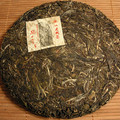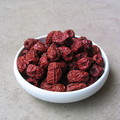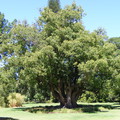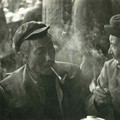Pu-erh tea
„Nèi fēi (内飞 or 內飛): A small ticket originally stuck on the tea cake but now usually embedded into the cake during pressing. It is usually used as proof, or a possible sign, to the authenticity of the tea. Some higher end pu'er cakes have more than one nèi fēi embedded in the cake. The ticket usually indicates the tea factory and brand.“
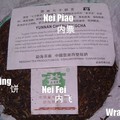
- Discussion: 0 comments
- Write a comment
Teas - Pu-erh
Lao ManE 2013 autumn
 1 review
1 reviewThe LaoManE rules over this autumn teas. In this village you may find really bitter tea...
2013 Spring Hekai Gu Shu Mao Cha
 1 review
1 reviewThe mao cha were picked on the same day from the same tea garden. Light yellow liquor...
2005 Nan Nuo Shan Raw Chi Tse Bing Cha
 1 review
1 reviewThis is a classic and old style cake from Nannuoshan Tea Factory which was renamed as...
1980's Zhongcha 8653 (HK/Malaysian
 0 reviews
0 reviewsProduced in the mid-late 1980's, these cakes were stored for the first 10-15 years of...
2014 White2Tea New Amerykah 2
 1 review
1 reviewAn old arbor Menghai blend. Thick body, lingering kuwei [pleasant bitterness], and...
2012 EoT Bulang Puer Tea 400g
 1 review
1 reviewThis tea was a bit of an experiment for us. We'd found 2 different maochas from Bulang...
Quotes - Pu-erh
„The most classical Puerh Tea is the Bingcha, recorded in Yong-Zheng 13th year in Qing Dynasty (1735). Each tea cake weighs 7 Liang (357 grams). Seven cakes make 1 Tong (wrapped in leaves), weighing 49 Liang. It was sold in nice places and also was exported abroad. It was re-named as "Yunnan Qizi bingcha - Yunnan seven cake tea" during the Cutural revolution.“
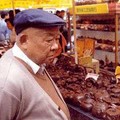
Quotes Tags: Pu-erh, Cake, Tea production, China
Video - Pu-erh
Theme
Teas
2006 Longyu Brand Bulangshan Jin Cha Raw 250g
 1 review
1 reviewRaw Jin Cha is especially for Tibetan market, used to be mixed with milk, it is very helpful for the...
2013 White 2 Tea New Amerykah
 2 reviews
2 reviewsThis puer tea cake is made from a 2013 pure Spring blend of gushu [old tree] material from the Menghai...
2005 Nan Nuo Shan Raw Chi Tse Bing Cha "7549"
 1 review
1 reviewThis is a classic and old style cake from Nannuoshan Tea Factory which was renamed as Menghai Banzhang Tea...
Tea by region
We will help you with tea selection.
Do you like quality loose tea?
We will help you to find the right one for you. Be inspired by tea ratings of other tea lovers. Rating stars could help you.


Review your cup of tea.
Review the tea you are drinking and help other tea lovers to find the right cup of tea.






 Shops
Shops Share on Facebook
Share on Facebook







